Volcano buried in Antarctic ice
- Share via
Researchers have discovered the first evidence of a volcano under the ice in West Antarctica -- a mountain that erupted about 2,300 years ago and may still be generating enough heat to speed glacial melting.
The blast ripped through thousands of feet of ice and sent ash eight miles into the sky. The ash settled in a giant elliptical shape and, over the centuries, was buried in snowfall, undetected until scientists found it in radar images from a series of airplane flights.
The extent of the ash, its thickness and its depth beneath the ice surface allowed researchers to calculate the size and date of the eruption, according to the report published this week in the journal Nature Geoscience.
The volcano, part of the Hudson Mountain Range, is considered active. “It may be producing a lot of heat underneath,” said lead author Hugh Corr, a researcher at the British Antarctic Survey.
That heat could play a small role in the melting of Pine Island Glacier, a massive ice floe that sits near the volcano and has been accelerating its movement toward the ocean in recent decades.
The melting of Antarctica’s glaciers is of interest to scientists because of fears that it could raise sea levels as a result of global warming. The entire ice sheet over West Antarctica has been thinning.
But Corr and other researchers said the effect of the volcanic activity was too small to change the dominant theory that warming ocean water was melting shore-bound sea ice, allowing glaciers to flow more quickly.
--






